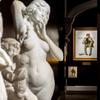An Age of Transformation: Women in Nineteenth Century Art
- March 16, 2015 13:58
This is the second of a three part series of blog posts preceding our exhibition Innocence, Temptation and Power: The Evolution of Women in Art, on view at M.S. Rau Antiques from March 27 – May 4.
From the mid-nineteenth century, Western Europe and the United States were witness to an extraordinary cultural and social upheaval. Truly a period of transformation, the end of the 19th century can be characterized also as an era of contradiction. As the great generation of French academic painters such as Jean-Léon Gérôme, with their idealized female figures and neoclassical subjects, slowly waned, a new group of radical young artists began to emerge who devoted their oeuvres to a new ideal of modernity. The Impressionists unapologetically painted their impressions of their modern bourgeoisie world, including the women within it, which was undergoing a rapid period of revolution.
While, in many instances, women still found themselves regarded as secondary citizens, it was the onset of industrialization and the corresponding growth of the middle class that began to expand the role of women in society. This provided ample inspiration for late 19th century artists, who themselves contemplated “the woman question” and the changing views of womanhood, femininity and what it meant to be a woman. Henri Toulouse-Lautrec’s La Promeneuse perfectly illustrates the Impressionist treatment of middle-class women during the Belle Epoqué – women who embody a new, avant-garde femininity without being idealized.
Indeed, traditional aesthetic ideals in general began to give way to a more revolutionary, individual artistic voice. In the same way, depictions of women in art slowly began to transform from object to subject in the eyes of the artist and the viewer, and the barrier between the private and public gradually began to descend. Yet, despite these advances, women were still expected to be the upholders of morality and put domestic and home responsibilities central in their lives. George Morren’s Le Renouveau (The Renewal) perfectly illustrates this juxtaposition. Depicting a wet-nurse breastfeeding a child, Morren places his female subject within a traditional “maternal” position, but also, more significantly, within a work scene. The “mother” in the scene is feeding the child not out of “natural” nurturing instinct but for wages, as a member of a flourishing industry. Both mother figure and worker, Morren’s wet-nurse epitomizes the updated, secularized Impressionist woman.
Undeniably, as the Impressionists begin to capture their own lived experiences of everyday life, the range and treatment of women as a subject in art similarly expanded, offering viewers a glimpse of the lived experience of the late 19th century woman through the Impressionist canvas. Themes of bourgeois leisure, bohemian spectacle, urban culture, and intimate spaces dominate the genre moving into the 20th century – subjects that will only continue to expand into the modern era.
To learn more about the story of women in art, please join us for Innocence, Temptation and Power: The Evolution of Women in Art, on view at M.S. Rau Antiques from March 27 – May 4.
About M.S. Rau Antiques:
M.S. Rau Antiques has spent over 100 years earning the trust of discerning collectors world-wide. Located in the heart of New Orleans’ historic French Quarter, our peerless gallery showcases some of the world’s most extensive and stunning works of important fine art by artists such as Monet and van Gogh, rare 18th-and 19th-century antiques and breathtaking jewelry, including rare colored diamonds.





















